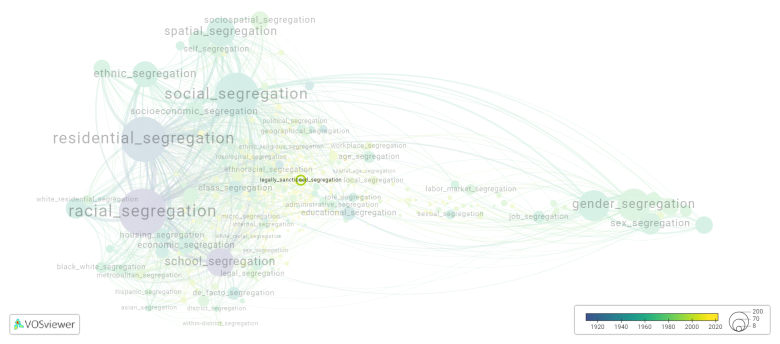Legally sanctioned segregation: Difference between revisions
(Creating page) |
(Creating page) |
||
| (8 intermediate revisions by the same user not shown) | |||
| Line 1: | Line 1: | ||
===== Date and country of first publication<ref>Date and country of first publication as informed by the Scopus database (December 2023).</ref>===== | |||
2007<br> | 2007<br> | ||
United States | United States | ||
===== Definition ===== | |||
Legally sanctioned segregation refers to policies or laws that enforce the separation and/or discrimination of individuals or groups based on characteristics such as race, ethnicity, religion, or socioeconomic status. Historically, these policies were prevalent in several countries, including the United States during the era of Jim Crow Laws, South Africa during apartheid, and Nazi Germany during the Holocaust. | Legally sanctioned segregation refers to policies or laws that enforce the separation and/or discrimination of individuals or groups based on characteristics such as race, ethnicity, religion, or socioeconomic status. Historically, these policies were prevalent in several countries, including the United States during the era of Jim Crow Laws, South Africa during apartheid, and Nazi Germany during the Holocaust. | ||
| Line 13: | Line 12: | ||
While legally sanctioned segregation is no longer prevalent in many countries, various forms of discrimination and inequalities still persist. Efforts to address and eliminate these inequalities are ongoing, aiming to create a more inclusive and equitable society for all. | While legally sanctioned segregation is no longer prevalent in many countries, various forms of discrimination and inequalities still persist. Efforts to address and eliminate these inequalities are ongoing, aiming to create a more inclusive and equitable society for all. | ||
==See also== | ==See also== | ||
==Related segregation forms== | |||
Legally sanctioned segregation is frequently discussed in the literature with the following segregation forms: | |||
[[social segregation]] | |||
[[File:legally_sanctioned_segregation.png|780x780px]] | |||
This visualization is based on the study [[Segregation_Wiki:About| The Multidisciplinary Landscape of Segregation Research]]. | |||
For the complete network of interrelated segregation forms, please refer to: | |||
* [https://tinyurl.com/2235lkhw First year of publication] | |||
* [https://tinyurl.com/2d8wg5n3 Louvain clusters] | |||
* [https://tinyurl.com/223udk5r Betweenness centrality] | |||
* [https://tinyurl.com/244d8unz Disciplines in which segregation forms first emerged (Scopus database).] | |||
==References== | ==References== | ||
==Notes== | ==Notes== | ||
<references /> | <references /> | ||
== | {{NoteAI}} | ||
==Legally sanctioned segregation appears in the following literature== | |||
West M.R. | West M.R., Peterson P.E. (2007). The adequacy lawsuit: A critical appraisal. ''School Money Trials: The Legal Pursuit of Educational Adequacy'', 1-22. Brookings Institution Press.https://doi.org/ | ||
Safransky S. (2018) | Safransky S. (2018). Land Justice as a Historical Diagnostic: Thinking with Detroit. ''Annals of the American Association of Geographers'', ''108''(2), 499-512. Taylor and Francis Ltd..https://doi.org/10.1080/24694452.2017.1385380 | ||
Latest revision as of 07:17, 16 October 2024
Date and country of first publication[1][edit | edit source]
2007
United States
Definition[edit | edit source]
Legally sanctioned segregation refers to policies or laws that enforce the separation and/or discrimination of individuals or groups based on characteristics such as race, ethnicity, religion, or socioeconomic status. Historically, these policies were prevalent in several countries, including the United States during the era of Jim Crow Laws, South Africa during apartheid, and Nazi Germany during the Holocaust.
During the era of legally sanctioned segregation in the United States, racial segregation was enforced in various sectors of society, such as schools, housing, transportation, and public facilities. These policies were supported and upheld by state and local laws, as well as court decisions, that justified separate facilities and services based on the false belief in racial superiority.
It is important to note that legally sanctioned segregation has been widely condemned as a violation of human rights and equality. It perpetuates systemic discrimination, marginalization, and inequality among various social groups. In the United States, significant progress has been made in dismantling legally sanctioned segregation through civil rights movements and legislation, such as the Civil Rights Act of 1964 and the Voting Rights Act of 1965.
While legally sanctioned segregation is no longer prevalent in many countries, various forms of discrimination and inequalities still persist. Efforts to address and eliminate these inequalities are ongoing, aiming to create a more inclusive and equitable society for all.
See also[edit | edit source]
Related segregation forms[edit | edit source]
Legally sanctioned segregation is frequently discussed in the literature with the following segregation forms:
This visualization is based on the study The Multidisciplinary Landscape of Segregation Research.
For the complete network of interrelated segregation forms, please refer to:
References[edit | edit source]
Notes[edit | edit source]
- ↑ Date and country of first publication as informed by the Scopus database (December 2023).
At its current state, this definition has been generated by a Large Language Model (LLM) so far without review by an independent researcher or a member of the curating team of segregation experts that keep the Segregation Wiki online. While we strive for accuracy, we cannot guarantee its reliability, completeness and timeliness. Please use this content with caution and verify information as needed. Also, feel free to improve on the definition as you see fit, including the use of references and other informational resources. We value your input in enhancing the quality and accuracy of the definitions of segregation forms collectively offered in the Segregation Wiki ©.
Legally sanctioned segregation appears in the following literature[edit | edit source]
West M.R., Peterson P.E. (2007). The adequacy lawsuit: A critical appraisal. School Money Trials: The Legal Pursuit of Educational Adequacy, 1-22. Brookings Institution Press.https://doi.org/
Safransky S. (2018). Land Justice as a Historical Diagnostic: Thinking with Detroit. Annals of the American Association of Geographers, 108(2), 499-512. Taylor and Francis Ltd..https://doi.org/10.1080/24694452.2017.1385380

